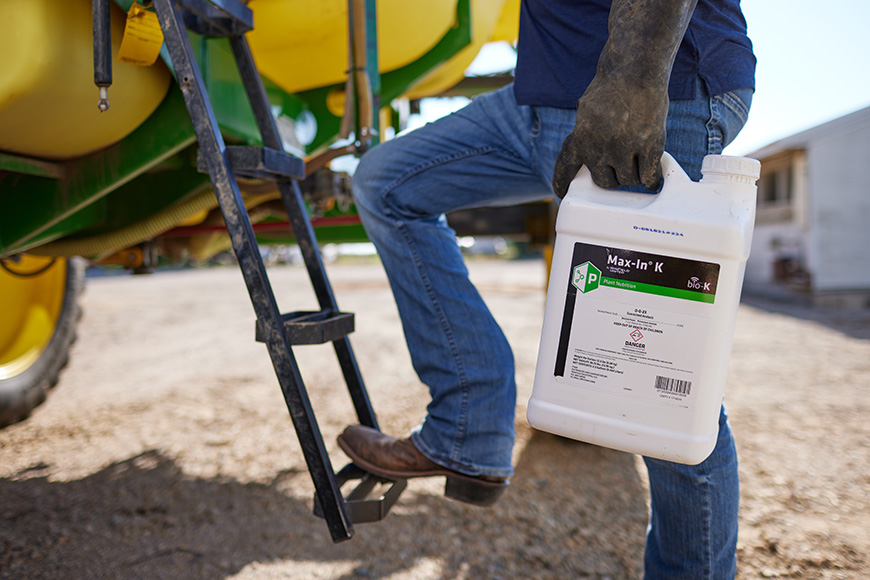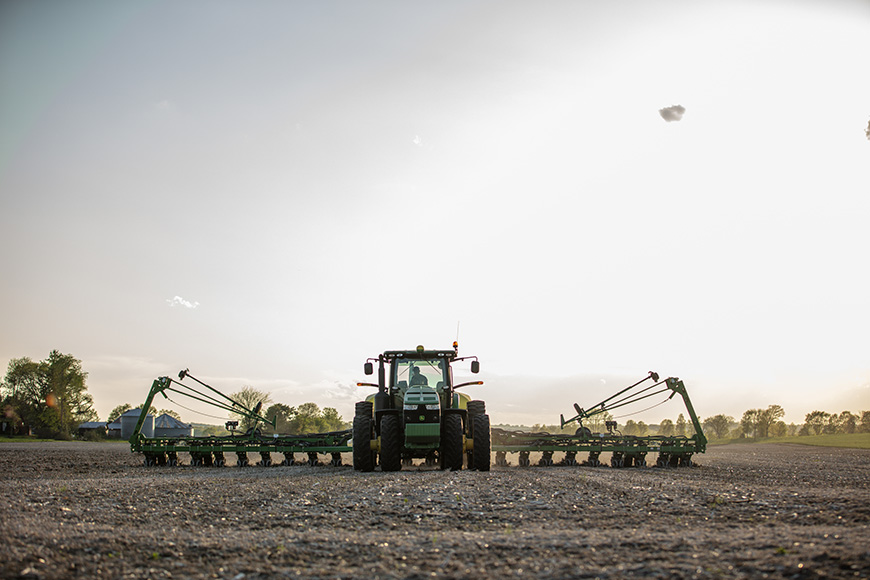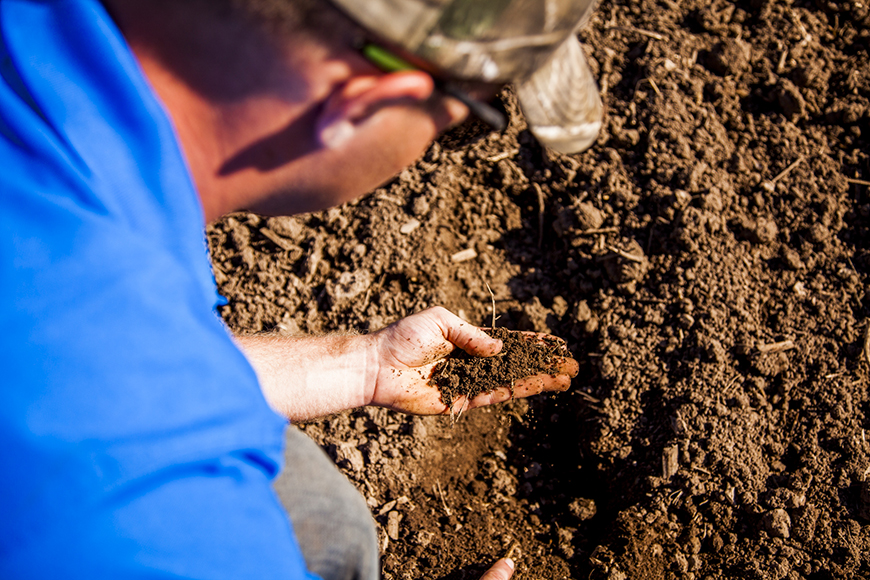When to Consider a Foliar Potassium Application

When talking about potassium (K), we’re typically talking about soil fertility and soil-applied potash. But have you ever considered making a foliar application in-season? According to tissue sample results, there is a clear need for additional potassium in-season. In fact, over the past five years, 67% of NutriSolutions® corn tissue samples at V14-V18 have shown a K deficiency as well as 75% of soybean samples at R1-R3.
MAX-IN® K is the latest addition to the MAX-IN family of foliar-applied liquid nutrient products and is designed to give crops a timely boost of K right when and where they need it most. While it comes with great benefits, it’s not a simple correlation from application to yield response, so let’s discuss how and when this product could be beneficial to your crop.
If you do have good soil levels, but your tissue test results are showing deficiencies, that is a signal the plant cannot uptake enough K through its roots no matter how much you have in the soil. This can happen for a number of reasons, such as varying weather conditions and physiological needs, and is an optimum opportunity for MAX-IN K. With a foliar application, you can get K into the plant without solely relying on root uptake.
Let’s explore another example. Say you’ve been increasing your nitrogen (N) rates year after year and have stopped seeing a yield benefit. Foliar K may be the next thing to help unlock that extra nitrogen through metabolic efficiencies since K helps neutralize negative charges within the plant making N more plant available.
Since N metabolism is a big key to plant health, MAX-IN K can also play a role in stress mitigation. The less energy the plant spends on utilizing N, the more energy it can focus on other areas. K is also a mobilizer for nitrogen and plays a major role in cell hydration. Since K helps facilitate these pathways that mitigate stress and support plant health, it provides a synergistic effect when included with other plant health applications, such as fungicides.
In addition to its plant health and nutritional benefits, MAX-IN K can also meet dicamba VRA requirements for some products, including Engenia® herbicide.
This dual-purpose foliar micronutrient is a great tool for refining your plant nutrition approach as you look to push your production to the next level. Contact your local WinField United retailer to learn more and order MAX-IN K.
*Data from internal WinField United research.
All photos are either the property of WinField United or used with permission.
© 2021 WinField United. Important: Before use always read and follow label instructions. Crop performance is dependent on several factors many of which are beyond the control of WinField United, including without limitation, soil type, pest pressures, agronomic practices and weather conditions. Growers are encouraged to consider data from multiple locations, over multiple years and to be mindful of how such agronomic conditions could impact results. CornSorb, MAX-IN, NutriSolutions and WinField are trademarks of WinField United. All other trademarks are the property of their respective owners.
MAX-IN® K is the latest addition to the MAX-IN family of foliar-applied liquid nutrient products and is designed to give crops a timely boost of K right when and where they need it most. While it comes with great benefits, it’s not a simple correlation from application to yield response, so let’s discuss how and when this product could be beneficial to your crop.
Why use foliar potassium
MAX-IN K is not designed or intended to fix a soil fertility issue. Instead, it’s meant for in-season adjustments and optimization to help the crop reach its potential. Before you make any foliar decisions, test the soil first and determine if soil levels are adequate. If they’re not, a foliar product is not going to solve the issue.If you do have good soil levels, but your tissue test results are showing deficiencies, that is a signal the plant cannot uptake enough K through its roots no matter how much you have in the soil. This can happen for a number of reasons, such as varying weather conditions and physiological needs, and is an optimum opportunity for MAX-IN K. With a foliar application, you can get K into the plant without solely relying on root uptake.
Let’s explore another example. Say you’ve been increasing your nitrogen (N) rates year after year and have stopped seeing a yield benefit. Foliar K may be the next thing to help unlock that extra nitrogen through metabolic efficiencies since K helps neutralize negative charges within the plant making N more plant available.
Since N metabolism is a big key to plant health, MAX-IN K can also play a role in stress mitigation. The less energy the plant spends on utilizing N, the more energy it can focus on other areas. K is also a mobilizer for nitrogen and plays a major role in cell hydration. Since K helps facilitate these pathways that mitigate stress and support plant health, it provides a synergistic effect when included with other plant health applications, such as fungicides.
When to apply foliar potassium
The most optimal time to apply MAX-IN K is during reproductive growth stages. Typically, this means applying it along with your tassel fungicide. As previously mentioned, NutriSolutions tissue test results have consistently shown K deficiencies in 67% of V14-V18 corn samples and 75% of R1-R3 soybean samples. Providing an extra nutritional boost to meet some of that K demand at fungicide timing has been shown to help with later season grain fill and nutrient uptake.What to look for in a foliar potassium product
Not all foliar K products are created equal. We thoroughly tested multiple options and chose the highest performing premium K source: potassium acetate. Compared to other sources, potassium acetate is the most mobile through the plant’s leaf cuticle. We also added our proprietary CornSorb® technology to further enhance absorption by increasing movement of nutrients through the leaf cuticle and into internal leaf structures. Compared to potassium alone, CornSorb technology improved nutrient uptake by up to 66%.*In addition to its plant health and nutritional benefits, MAX-IN K can also meet dicamba VRA requirements for some products, including Engenia® herbicide.
This dual-purpose foliar micronutrient is a great tool for refining your plant nutrition approach as you look to push your production to the next level. Contact your local WinField United retailer to learn more and order MAX-IN K.
*Data from internal WinField United research.
All photos are either the property of WinField United or used with permission.
© 2021 WinField United. Important: Before use always read and follow label instructions. Crop performance is dependent on several factors many of which are beyond the control of WinField United, including without limitation, soil type, pest pressures, agronomic practices and weather conditions. Growers are encouraged to consider data from multiple locations, over multiple years and to be mindful of how such agronomic conditions could impact results. CornSorb, MAX-IN, NutriSolutions and WinField are trademarks of WinField United. All other trademarks are the property of their respective owners.





.jpg?ext=.jpg)